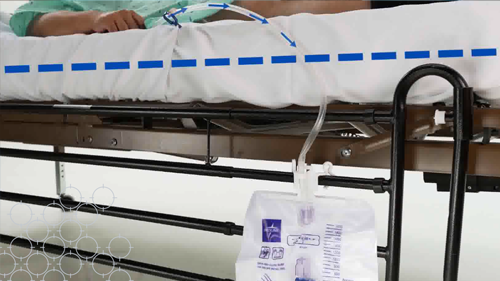Alternatives to IUCs: How to fight CAUTIs and improve patient comfort
Learn how to avoid indwelling urinary catheters with innovative products.

When it comes to keeping patients safe from catheter-associated urinary tract infections (CAUTIs), the numbers say it all:
- CAUTI rates in US hospitals increased 43% in 2020 after years of steady decline1
- In the US, up to five million indwelling urinary catheters (IUCs)—or Foleys—are placed annually, with as many as half not being necessary2
- When an IUC is in place, a patient’s daily risk of developing a CAUTI ranges from 3 to 7%3
- Up to 380,000 infections and 9,000 deaths related to CAUTI per year could be prevented—and $450 million in excess care costs avoided2
In 2009, the Centers for Disease Control and Prevention’s (CDC) Healthcare Infection Control Practices Advisory Committee (HICPAC) created guidelines for appropriate and inappropriate indications for IUC placement, with recommendations refined in 2015.4 These include acute urinary retention, perioperative use, palliative care and prolonged immobilization.
“If all the physician needs is a 24-hour total of urinary output, you can measure the volume with viable alternatives,” says Mary Pat Eble, RN, Medline National Clinical Product Specialist-Urology.
3 alternatives to IUCs
Alternative methods to IUCs help reduce unnecessary IUC use and lower CAUTI rates. They also help decrease or eliminate noninfectious complications—discomfort, immobility—associated with IUCs. Over the last several years, new options have been introduced relative to external catheters. Performance, patient comfort and ease of use have increased with these alternatives.4
2.5 million
IUCs are unnecessarily placed each year in the US3
Here’s how they work:
Bladder scanner
A bladder scanner can be used to assess and confirm urinary retention before an IUC is placed to address suspected urinary retention; the scan reduces unnecessary catheterization when the bladder’s volume is not the cause of the patient’s symptoms.4 Studies have shown that using bladder ultrasound can reduce catheterization rates by 30 to 50%.3
Intermittent (straight) catheter
An intermittent catheter is a soft, flexible tube with tiny openings in the end that is used to drain urine from the bladder via the urethra. These one-time use devices are inserted and removed several times a day. Intermittent catheters are most often used in patients with neurogenic bladder or spinal cord injury, lessening the risk of UTIs compared with chronic IUCs.4 Performing intermittent catheterization provides the patient with greater mobility and ensures an IUC is not left in place longer than necessary.3
The American Nurses Association (ANA) CAUTI Prevention Tool recommends intermittent catheterization of patients with acute urinary retention as opposed to insertion of an IUC. Most acute urinary retention can be relieved by following this algorithm.5
External catheters
An external urinary catheter is not inserted in the kidney, like a stent or nephrostomy tube, or in the bladder or urethra, like an indwelling (Foley) or a catheter inserted for intermittent drainage. It is placed externally, adhering to the genitalia or pubic area to drain urine in persons with urinary incontinence. External urinary catheters are often referred to as “bodyworn products,” as the devices are applied (attached) on the body.6
External male catheters, or “condom” catheters, are used as collection devices for collecting and containing urine via tubing that relies on gravity to drain urine away from the penis or perineum into a drainage bag, or suction that pulls urine into a container. These devices have been shown to lower the risk of bacteriuria or symptomatic UTI.
Condom catheters have been around for a while. Older versions may leak, irritate skin and be painful to remove. Today’s generation of male external catheters are made with gentler materials. For example, a product with a faceplate made of soft hydrocolloid requires minimal surface coverage for a complete seal, directing urine away from skin. These options provide increased patient comfort and allow more mobility than IUCs.3 They also perform better and are easier to use.4
External female catheters are also available. These devices conform to the perineal area between the labia, against the urethra. The catheter is connected to low continuous suction, providing a sump mechanism to collect and measure urine output. In addition, there is a continuous air flow promoting a microclimate environment to the female perineum region. The device allows for ongoing monitoring of continuous output, aids in the provision of patient dignity and reportedly improves nurse satisfaction.7
Innovations include a pad and tubing that uses low pressure suction to pull urine into canister. The pad is held in place by a soft mesh underwear. These newer devices are designed for a better and more comfortable fit, lower risk of pressure injury and more effective incontinent control.
8 appropriate indicators for external urinary catheters
External urinary catheter use is encouraged for the following scenarios:
- Treat male or female patients who experience urinary incontinence (UI) without urinary retention, including long-term care residents in nursing homes; patients who are obese and have limited movement; and those patients with UI secondary to neurogenic lower urinary tract dysfunction (NLUTD) without sensory awareness due to paralyzing spinal disorders such as spinal cord injury, transverse myelitis or progressive multiple sclerosis
- Respond to patient/caregiver requests for an external device to manage and collect urine leakage
- Provide a containment system for male patients who have undergone prostate surgery, are experiencing stress incontinence and are ready to return to work or usual activities
- Collect daily (not hourly) measurement of urine volume that is required (such as for a hospitalized patient) and cannot be assessed by other volume and urine collection strategies in acute care situations
- Collect single 24-hour or random nonsterile urine sample for diagnostic tests that cannot be obtained by other urine collection strategies
- Reduce or minimize acute, severe pain that is a result of movement when other urine management strategies are difficult (for example, turning a patient to remove an absorbent pad causes pain)
- Manage overactive bladder symptoms and improve comfort in end-of-life care and palliative care patients
- Promote restful sleep during the night and reduce the risk for falls by minimizing the need to get up to urinate
These devices are not indicated for the management of urinary obstruction or urinary retention.8
Take advantage of guidance
Each organization should adopt explicit criteria for appropriate and inappropriate catheter insertion, taking into account modifications for specific populations as needed. When IUC placement is indicated, it’s essential that properly trained clinicians insert the catheters using aseptic technique, maintain the catheters using recommended guidelines, review the catheter necessity daily and remove promptly. Finally, nursing and other clinical staff need to be empowered and expected not to proceed with catheter insertion when criteria are not met and to contact physicians to clarify and discuss alternatives.3
Resources are available to help you ensure you’re on track with your CAUTI prevention efforts. For example, the ANA’s CAUTI prevention tool includes a decision tree for determining when IUCs are necessary.5 You may also want to collaborate with an external partner to ensure you have the right protocols in place and products on hand—and that clinicians are properly educated.
Key takeaway
CAUTIs are among the most common healthcare-associated infections (HAIs), and the majority of cases are preventable.2 IUCs increase the risk of CAUTI and are often used unnecessarily. Consider today’s advanced alternatives that help you avoid IUC use, reduce CAUTI rates and keep patients safe.
References:
- Masson, Grabrielle. Sharp drop in patient safety, infection control amid pandemic: 3 new findings. Becker’s Clinical Leadership & Infection Control. February 14, 2022.
- Guideline for Prevention of CAUTIs 2009. Available at: https://www.cdc.gov/infectioncontrol/pdf/guidelines/cauti-guidelines-H.pdf.CDC. Infection Control/Catheter-Associated Urinary Tract Infections. Available at:
- Institute for Healthcare Improvement (IHI). How-to Guide: Prevent CAUTI. 2011.
- Agency for Healthcare Research and Quality (AHRQ). Toolkit for Reducing Catheter-Associated Urinary Tract Infections in Hospital Units: Implementation Guide. Accessed February 10, 2022.
- American Nurses Association. ANA CAUTI Prevention Tool. Available at: https://www.nursingworld.org/practice-policy/work-environment/health-safety/infection-prevention/ana-cauti-prevention-tool/
- Newman, Diane, DNP, ANP-BC, FAAN, UroToday. Introduction: External Urinary Catheters. April 2020. Available at: Introduction: External Urinary Catheters (urotoday.com)
- Beeson, Terrie; and Davis, Carmen. Urinary Management with an External Female Collection Device. J Wound Ostomy Continence Nurs. 2018 Mar; 45(2): 187–189. Available at: https://www.ncbi.nlm.nih.gov/pmc/articles/PMC5865498/
- Newman, Diane, DNP, ANP-BC, FAAN, UroToday. Indications: External Urinary Catheters. April 2020. Available at: Indications: External Urinary Catheters (urotoday.com)




